As it has snowed the past week in Lapland for the first time this autumn, I think it is suitable to show you some winter pictures now in the beginning of winter. You can check out the snow situation in Kilpisjarvi here.
If you visit the little village of Kilpisjarvi in Finland you are just 7 km from the crossing of the border to Norway. Kilpisjarvi is a very small village, and its known history is young. The first permanent inhabitants came to the village as late as 1915. Anyway, nothing remains from those years, since it all was demolished in the Lapland War 1944-1945. In the end of WW 2 Finland had to drive the former allies, the German forces, away. The Germans retreated towards north and then to Norway. German forces burnt everything behind them. This retreat and burning of structures left behind is called Lapland War. The road to and from Kilpisjarvi was much improved during the war because during the WW 1 (1914-1918) large amounts of war materials were transported through Kilpisjarvi to vicinity of Tornio. All this material was meant for the Russian front. At the most, between 1915-1916, 1400 horses were in duty to transport military materials on this road. This road, the Northern light road, is the only road in this area, so the Swedes and the Norwegians also use this road for transports to their fells. Kilpisjarvi is a very popular village to Norwegians and they spend holidays here both in summer and in winter time.
Treriksröset (in Swedish), Treriksrøysa (in Norwegian), Kolmen valtakunnan rajapyykki (in Finnish) is the special point at which the borders of Sweden, Norway and Finland meet.
 The name can be translated into English as “Three-Country Cairn”, and is named for the monument of stones erected in 1897 by the governments of Norway and Russia (which was administering Finland at that time). The Swedish could not agree on a boundary commission with the Norwegians and did not bring their stone until 1901. This is Sweden’s most northerly point and it is the westernmost point of the Finnish mainland.
The name can be translated into English as “Three-Country Cairn”, and is named for the monument of stones erected in 1897 by the governments of Norway and Russia (which was administering Finland at that time). The Swedish could not agree on a boundary commission with the Norwegians and did not bring their stone until 1901. This is Sweden’s most northerly point and it is the westernmost point of the Finnish mainland.
It is reached by walking 11 kilometres from Kilpisjarvi on a public road. In summertime it can be reached by boat from Kilpisjarvi plus a 3 kilometres walk.
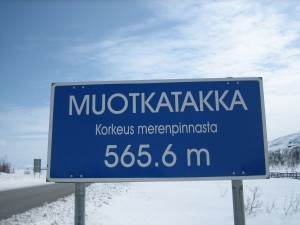 To drive from Rovaniemi to Kilpisjarvi by car takes about 5-6 hours. You drive along the Northern Light route and before you end up in Kilpisjarvi you will pass by a place called Muotkatakka. This is where the highest situated road in Finland is. It is on 565,6 meter above the sea level. On this place, Muotkatakka, you can also find a monument that tells you this is the place where the last cannon shots against the retreating German forces were shot in the Lapland War in 27.4.1945.
To drive from Rovaniemi to Kilpisjarvi by car takes about 5-6 hours. You drive along the Northern Light route and before you end up in Kilpisjarvi you will pass by a place called Muotkatakka. This is where the highest situated road in Finland is. It is on 565,6 meter above the sea level. On this place, Muotkatakka, you can also find a monument that tells you this is the place where the last cannon shots against the retreating German forces were shot in the Lapland War in 27.4.1945.
After you have been on the highest place of the road, the road starts to go down again and finally you will see a silhouette of a fell that is nothing like the surrounding fells at all. This is the fell Saana and the little Kilpisjarvi village is situated at the foot of Saana fell by the Kilpisjarvi lake. On the opposite shore of Kilpisjarvi lake is the border to Sweden. .
Saana has received its name from the word of Saami language meaning a certain mushroom. From one angle the fell does look like a mushroom. Some people think it looks like an overturned boat with a keel. For the Saami people it is a sacred mountain. Fires were burned to the God of Thunder on top of it. The peak is 1029 meters above sea level and 556 meters up from the Kilpisjarvi lake’s surface. Saana is the 25th tallest fell in Finland, but second most known because of its impressive shape.
According to the legend – long ago Kilpisjarvi area was inhabited by giants. Sullen Saana (the fell) got a crush on lovely Malla (the fell next to Saana). On the wedding day Pältsä (that is a fell on the Swedish side of the border) wanted to stop the wedding ceremony. He had found out he was also in love with Malla. The wedding ceremony would have been held by Paras (a fell on the Norwegian side of the border), and he was known as the magician. But Pältsä had called the evil elderly women of Lapland to come to Kilpisjarvi. All of a sudden a fierce northern wind wiped all the celebrants with ice-cold wind. Very soon the area was frozen and filled with ice. At the last moment, Saana pushed the lovely Malla over to her mother’s, Big Malla’s arms. (There are two Malla fells just near one another). At that moment the freezing cold took away all life in the area. Malla cried, and from her tears Kilpisjarvi – the lake was formed. The lake is situated in between Saana and Malla fells.
Read more about the area around Saana fell here.


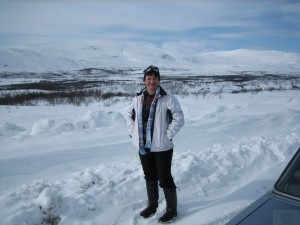

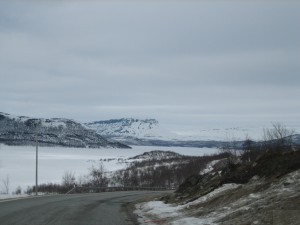

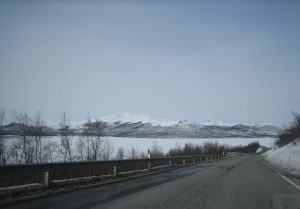
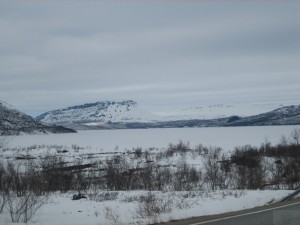

Pingback: Ice-fishing expedition to the Upper-North of Lapland, part 2 | Grandma in Lapland